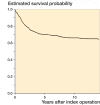High rate of reoperation and conversion to total hip arthroplasty after internal fixation of young femoral neck fractures: a population-based study of 796 patients
- PMID: 30712497
- PMCID: PMC6366467
- DOI: 10.1080/17453674.2018.1558380
High rate of reoperation and conversion to total hip arthroplasty after internal fixation of young femoral neck fractures: a population-based study of 796 patients
Abstract
Background and purpose - Most often, the goal of non-geriatric femoral neck fracture surgery is to preserve the native hip joint. However, reoperations for painful implants, osteonecrosis, and nonunion are common. We determined the reoperation rate and time-to-reoperation following internal fixation of these fractures in a large population cohort. Patients and methods - This retrospective cohort study included patients between the ages of 18 and 50 years old who underwent internal fixation for a femoral neck fracture during 1997-2013. Patients were followed until December 2013. Primary outcomes were reoperation rate and time-to-reoperation. Time-to-event analysis was performed to estimate the rate of any reoperation and for THA specifically, while testing the dependency of time-to-reoperation on secondary variables. Results - 796 young femoral neck fracture patients were treated with internal fixation during the study period (median age 43 years, 39% women). Median follow-up was 8 years (IQR 4-13). One-third underwent at least 1 reoperation at a median 16 months after the index surgery (IQR 8-31). Half of reoperations were for implant removal, followed by conversion to total hip arthroplasty. 14% of the cohort were converted to THA. The median time to conversion was 2 years (IQR 1-4). Neither female sex nor older age had a statistically significant effect on time-to-reoperation or time-to-THA conversion. Interpretation - Following internal fixation of young femoral neck fracture, 1 in 3 patients required a reoperation, and 1 in 7 were converted to THA. These data should be considered by patients and surgeons during treatment decision-making.
Figures
References
-
- Angelini M, McKee M D, Waddell J P, Haidukewych G, Schemitsch E H. Salvage of failed hip fracture fixation. J Orthop Trauma 2009; 23(6): 471–8. - PubMed
-
- British Columbia Ministry of Health Consolidation File (MSP Registration & Premium Billing). V2. Population Data BC. Data extract. MOH; 2016a. http://www.popdata.bc.ca/data.
-
- British Columbia Ministry of Health Medical Services Plan (MSP) Payment Information File. V2. Population Data BC. Data extract. MOH; 2016b. http://www.popdata.bc.ca/data.
-
- Canadian Institute for Health Information Discharge Abstract Database (Hospital Separations). V2. Population Data BC. Data extract. MOH; 2016. http://www.popdata.bc.ca/data.
MeSH terms
LinkOut - more resources
Full Text Sources
Medical

